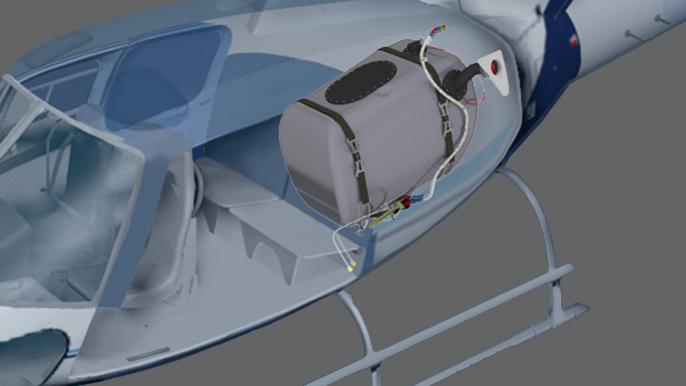
Surviving a helicopter crash can depend on the presence of crash-resistant components. While newer helicopters are factory equipped with the latest crash-resistance technology, many legacy ones are not, putting passengers and pilots at greater risk of injuries or death. Older fuel tanks are among the most hazardous to survivability in the event of a crash.
Legacy helicopters tend not to employ fuel system crash-resistance, says Jeff Bracken, chief technology officer and VP of engineering at Robertson Fuel Systems in Tempe, Arizona. “They use plastic fuel containers that rupture and spill flammable fluid in the event of a crash,” he says. “The Robertson Crash Resistant Fuel Tank (CRFT) was specifically designed to withstand crash impacts, mitigating the risk of fuel leakage and a potential post-crash fire.”
According to Bracken, the CRFT adapts military grade fuel-tank technologies, which incorporate a crash-resistant fuel bladder placed inside of a composite fuel container. All fuel gauges and breakaway valve connections are crash-resistant as well.
The CRFT, says Bracken, has a capacity of 143 lb. (64.86 kg) of usable fuel, and a 50-lb. (22.68-kg) empty weight increase over legacy systems. “Testing was done in accordance with FAR [Part] 27.952 fuel system crash-resistance regulations, which mandate the capability of the tank to sustain its integrity in a crash landing,” he remarks. The system was drop-tested from a 50-ft. height on a non-deforming surface with full fuel capacity by weight. “It was installed in a helicopter airframe without landing gear and no leakage was allowed,” he says.
The CRFT testing went beyond FAA regulations and minimum safety requirements, and included flammable-fluid fire protection, lightning and static electricity protection, and electromagnetic interference (EMI), stresses Bracken. Testing, he reports, was also done to DO-160, an environmental qualification standard for airborne products developed by the Radio Technical Commission for Aeronautics (RTCA).
Certified by the FAA and the European Union Aviation Safety Agency (EASA) in December 2017 and June 2018, respectively, Robertson’s CRFT is available under an STC developed in partnership with StandardAero--which is the STC holder. The STC is specifically for retrofit on Airbus AS350 helicopter variants and the Airbus EC 130 B4. To date, 155 retrofit kits have been delivered by StandardAero to its customers.
“The AS350 variants were selected due to the popularity of the variants for missions that can benefit from crash-resistant fuel tanks and post-crash fire mitigation, like tourism and EMS [emergency medical service],” says Bracken. “ In fact, we targeted air medical operators as the highest risk group.”
StandardAero, itself, sees a large market for the Robertson CRFT, according to Elvis Moniz, VP business development airframes and avionics solutions for the company’s helicopters business unit.
“There are well over 3,000 AS350/H125s flying in the world today, most of which fall well short of meeting today’s crash-resistant fuel system standards,” Moniz notes. “As a result, all of these aircraft are prime candidates for this occupant safety-enhancing solution.”
One of the system’s design features is ease of installation, he notes. “The intrinsic durability of the container, which is much sturdier and more reliable than riveted aluminum or plastic containers, allows the CRFT to be installed using both original OEM sheet-metal cradles or machined cradles without penetration. There are no intrusive structural modifications to the airframe needed for installation. This allows for field installation that is typically completed within two to three days.”
Moniz points out that StandardAero took real-life emergency landing situations into consideration throughout the testing phase. That included working with leading cargo swing system manufacturers to incorporate their cargo swings in the drop testing. “We certified the tank to the very worst threat of penetration,” he says. “Our tank is fully certified to be compatible with both Airbus Helicopters and Onboard Systems International cargo swing systems.”

Crash-resistant fuel system (CRFS) solutions are also offered by helicopter OEMs. For example, Bell has included them for both line and retrofit since 1980, according to Karl Burge, a staff engineer. Bell, he notes, commenced implementation of CRFS in the early 1980s for its commercial product line, specifically the Bell 412, 206L3 and 206L4.
“We have offered retrofit CRFS for pre-1980 Bell helicopters for the past 30 years,” Burge explains. “We believe CRFS is a very important safety feature and all current production helicopters should be delivered from the factory with the system. At Bell, they are standard on all current production models.”
But Burge adds a cautionary note. “There is confusion where people think a system is CRFS because it contains a bladder. That is not true,” he stresses. “Just because a helicopter--Bell or other manufacturer--has a fuel bladder does not mean that bladder’s integrity was validated through drop testing. CRFS designs require some form of drop testing to validate the bladder can retain the liquid when dropped from a given height.”
Non-CRFS fuel bladders met all the requirements at the time they were installed says Burge. “But the ultimate goal of a CRFS is for the bladder to resist puncture, to be capable of reacting to the hydrodynamic forces at impact, and to retain fuel after a survivable crash,” he says.
Seating Mod
In addition to fuel tank systems, crash-resistant seating is also viewed as a way to greatly reduce the chance of injury or death in the event of a helicopter accident. As is the case with many aviation-related components, current design trends are favoring the use of state-of-the-art composites.
According to Malte Scherner, executive manager of programs at AAT Composites in South Africa, composite materials can be very effective in crash resistance because they can absorb high amounts of energy with relatively little material usage. “Our focus has been on making our [seat] buckets meet all safety requirements, including crash-resistance, while meeting the cost and weight targets of our customers,” he says.
Scherner reports that currently, AAT Composites--a subsidiary of Recaro Aircraft Seating--is manufacturing four different seat buckets for the civil helicopter market, including buckets designed as “monolithic and hollow structures,” which incorporate a combination of glass and carbon fiber, offering different cost-to-weight ratios.
“We believe that composite materials [are] the perfect symbioses of cost and weight for a helicopter seat and foresee a growing market for composite buckets for helicopters and similar aircraft,” he says.
Along this line, Scherner stresses that composite buckets meet “all relevant regulatory requirements with regard to stress and environmental loads” over the entire lifetime of the seat. “This includes a full 30G downward dynamic stress test,” he says. “Our newest development achieves this and is lighter and more cost effective to manufacture, compared to older models.”
The composite buckets, he adds, are part of a complete seat assembly. “It is this assembly that needs to function as a whole when designing for airworthiness,” he notes.
Crash tests have shown controlled deformation of the composite shell structure. This deformation contributes to the energy absorption and prevents load spikes, which otherwise would be transferred to the passenger’s or pilot’s body. “However, it is important that the deformation remains elastic and bounces back, as the sharp edge of an open break of the composite structure would be an additional risk,” he says.






